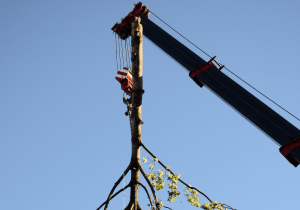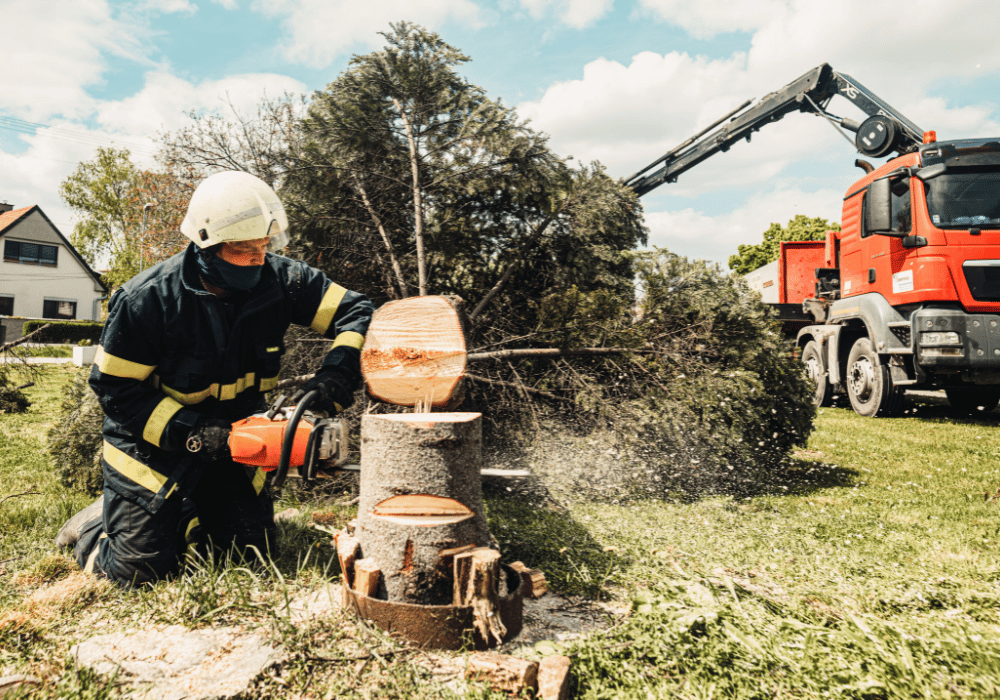When navigating the complexities of tree removal, understanding the methods available is crucial. For challenging scenarios where trees are large, hazardous, or located in hard-to-reach areas, two primary techniques dominate the industry: crane-assisted tree removal and climbing tree removal. Both options ensure safety and precision but differ in execution. Below, we’ll compare these approaches, outlining their unique benefits, limitations, and best-use cases to help homeowners and property managers make informed decisions.
Understanding Crane-Assisted Tree Removal
 Crane-assisted tree removal is a modern and highly efficient technique. It involves using a crane to lift and remove sections of a tree, ensuring a controlled and precise removal process. This method is often the go-to solution for removing large trees in confined spaces, where traditional methods might pose greater challenges.
Crane-assisted tree removal is a modern and highly efficient technique. It involves using a crane to lift and remove sections of a tree, ensuring a controlled and precise removal process. This method is often the go-to solution for removing large trees in confined spaces, where traditional methods might pose greater challenges.
The primary advantage of crane-assisted tree removal is its ability to simplify complex scenarios. The crane eliminates the need for climbers to dismantle the tree piece by piece, greatly reducing the time required for the project. Additionally, this method is less invasive, preventing damage to surrounding property, landscaping, or structures. For instance, in suburban neighborhoods with narrow yards or trees near houses, the crane operator can pluck tree sections directly over obstacles, minimizing risk.
However, this approach does require certain conditions. Adequate crane access is critical; without clear entry points, the equipment cannot be positioned effectively. Furthermore, crane-assisted tree removals can be more expensive than traditional methods, given the specialized equipment and skilled operators involved.
Exploring Climbing Tree Removal
Climbing tree removal is a time-tested method that relies on experienced arborists equipped with ropes, harnesses, and other tools to ascend and dismantle a tree piece by piece. This hands-on approach is versatile, allowing arborists to handle trees in locations where cranes simply cannot reach.
One of the key benefits of climbing tree removal is its ability to tackle trees in tight spaces. For example, trees growing behind houses, near power lines, or in wooded areas with no crane access are excellent candidates for this approach. Arborists can move through branches with precision, ensuring every cut is deliberate and safe. Additionally, this method is often more budget-friendly than crane-assisted removal, depending on the tree’s size and complexity.
That said, climbing tree removal can be labor-intensive and requires a higher degree of physical endurance and skill. It also typically takes longer than crane-assisted methods, especially for larger trees. Despite these challenges, when executed by a certified arborist, climbing tree removal is remarkably safe and efficient.
Comparing Speed and Efficiency
When time is a critical factor, crane-assisted removal often has the upper hand. The use of heavy machinery allows for the rapid dismantling and extraction of even the largest trees. For instance, what might take a team of arborists an entire day to accomplish through climbing could be completed in a few hours with a crane.
On the other hand, climbing tree removal is less dependent on external factors like equipment availability or setup. Arborists can begin work as soon as they assess the tree and gather their tools. While it may take longer for them to finish, this method is valuable for locations where cranes would require significant time for site preparation or maneuvering.
Ultimately, the speed and efficiency of a method depend not only on the technique itself but also on the specifics of the situation. Property owners should weigh the urgency of the project against logistical challenges like access or tree condition.
Assessing Safety Considerations
Safety is paramount in any tree removal project, and both methods have strong safeguards when executed by professionals. Crane-assisted tree removal minimizes the need for climbing and cutting at height, significantly reducing the risk to arborists. The crane operator controls tree sections remotely, keeping team members safely on the ground as much as possible.
Climbing, however, depends heavily on the expertise and training of the climber. Certified arborists follow rigorous safety protocols, using advanced equipment like helmets, harnesses, and ropes to mitigate hazards. While the physical presence of a climber in the tree adds some risk, these professionals are trained to assess and respond to potential challenges.
For particularly hazardous trees—such as those damaged by storms or showing signs of decay—cranes are often preferable due to the enhanced safety measures they afford. Arborists can avoid direct engagement with unstable branches or trunks, reducing the chance of accidents.
Cost Implications of Both Methods
 Cost is a significant factor influencing the choice between crane-assisted and climbing tree removal. While crane-assisted methods offer unmatched efficiency, they often involve higher upfront costs due to the need for specialized equipment and operators. Property owners should also consider additional expenses like permits, which may be necessary depending on local regulations.
Cost is a significant factor influencing the choice between crane-assisted and climbing tree removal. While crane-assisted methods offer unmatched efficiency, they often involve higher upfront costs due to the need for specialized equipment and operators. Property owners should also consider additional expenses like permits, which may be necessary depending on local regulations.
Conversely, climbing tree removal is generally more budget-friendly for smaller, less complex jobs. The total cost will depend on factors like the tree’s size, condition, and location, as well as the time and labor required. For example, removing a medium-sized tree in an easily accessible yard may cost significantly less than utilizing a crane for the same task.
Ultimately, the best approach depends on weighing the overall value of each method. While the initial cost of crane-assisted removal may be higher, the time saved and reduced risk of property damage can justify the investment for many property owners.
Choosing the Right Method for Your Needs
Deciding between crane-assisted and climbing tree removal requires a thoughtful assessment of your specific circumstances. If the tree is large, hazardous, or located in a restricted area, crane removal may be the safest and most efficient option. Alternatively, for trees in hard-to-access spaces or areas unsuitable for heavy equipment, climbing provides a tried-and-true solution.
Consulting with an experienced tree removal company, like 855TREEMAN, can help simplify the decision process. Professionals can evaluate your property, consider tree conditions, and recommend the most effective removal technique. Regardless of which method you choose, ensuring it is performed by skilled professionals is key to achieving a safe and satisfactory outcome.
When it comes to difficult trees, both crane-assisted and climbing tree removal methods have distinct advantages. Each technique plays a vital role in ensuring safety, efficiency, and precision, depending on the unique challenges of the project. By understanding these methods and consulting with experts, homeowners can confidently choose the right approach to maintain the beauty and safety of their property.


